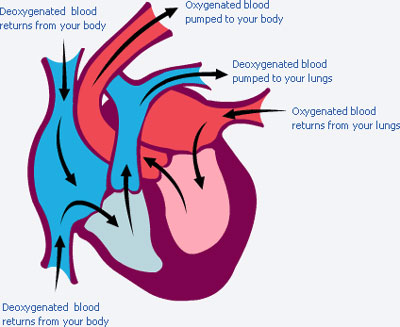
Strength Training for a Healthy Heart
Regular exercise is a critical part of staying healthy. People who are active live longer and feel better. But what form
of exercise is best? The standard teaching has been 30 minutes per day, five days a week of cardiovascular training, and
three days a week of strength training. However, there has been a recent breakthrough in training approaches that focus
on strength training for cardiovascular health.
Cardiovascular Health
 The function of the cardiovascular system is to pump oxygen and nutrient-rich blood throughout the body and to remove waste
products like carbon dioxide. The heart is a powerful muscle that contracts, expands, and hypertrophies, as other muscles
do when worked. As the heart gets stronger, blood pressure and heart rate go down because the heart gets more efficient
and can pump out more blood per beat.
The function of the cardiovascular system is to pump oxygen and nutrient-rich blood throughout the body and to remove waste
products like carbon dioxide. The heart is a powerful muscle that contracts, expands, and hypertrophies, as other muscles
do when worked. As the heart gets stronger, blood pressure and heart rate go down because the heart gets more efficient
and can pump out more blood per beat.
Strength Training
Strength training, often called resistance training, refers to exercises that require muscles to exert a force against some
form of resistance. The most common form of strength training is lifting weights, e.g., free weights, machines, elastic
bands, body weight, or any other form of resistance. These types of exercises are known for developing and toning muscles,
helping to develop and maintain the integrity of bones, increasing metabolism by increasing lean muscle mass, building stronger
connective tissue and greater joint stability, and decreasing body fat. Strength training is beneficial for everyone. It
is especially beneficial as we grow older because muscle mass naturally diminishes with age, and strength training will
help prevent this muscle loss and rebuild what may have been lost.
Strength training as a component of a cardiac rehabilitation program is well-recognized by clinicians; however, it is now
just coming to the forefront of preventive medicine for its profound effect in reducing the risks of cardiovascular disease.
There have been several research studies on the effect of high-intensity, short rest weight training and its effect on cardiovascular
health and fitness. The findings are remarkable as strength training has not generally been thought to improve cardiovascular
fitness. Aerobic activities that increase heart rate and make one breathe harder— walking, biking, and jogging—have typically
been recommended for cardiovascular fitness. We are now learning that maximum increases in strength and cardiovascular fitness
can be obtained from one type of exercise—strength training. Properly applied, strength training simultaneously engages
both the muscular system and the cardiovascular system. Recommended intervals are three to five times per week for 20 to
30 minutes at a moderate intensity-level, or two to three times per week for 15 to 20 minutes at a high-intensity level.
The American Heart Association (AHA) says that for healthy adults, a regular program of weight training not only increases
muscle strength and endurance, it also improves heart and lung function, enhances glucose metabolism, reduces coronary disease
risk factors, and boosts well-being. When our muscles are stronger, there is less demand placed on the heart. This allows
the lungs to process more oxygen with less effort, the heart to pump more blood with fewer beats, and the blood supply directed
to your muscles to increase.
Strength training provides numerous health benefits. It can be very powerful in preventing and reducing the signs and symptoms
of numerous diseases and chronic conditions such as obesity, diabetes, cardiovascular disease, osteoporosis, arthritis,
and mild depression. Additionally, it can help individuals recover from and prevent injury, improve endurance, flexibility,
stamina, balance, and coordination. The idea is simple: strength is good. According to the AHA, strength increases "functional
capacity," which is the ability to perform daily activities. Being physically strong will decrease the strain that day-to-day
tasks, such as lifting, place on the heart.
Prior to beginning any form of exercise program, it's important to see your physician for a complete physical examination
to ensure you are healthy enough to begin an exercise regimen without risk. Share with them your health goals and exercise
plan, and seek their recommendations, especially those related to nutrition and smoking cessation.
Remember: regular strength training does more than just build better, stronger muscles-it builds a better, stronger, healthier
body.